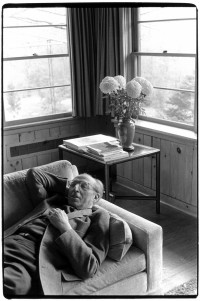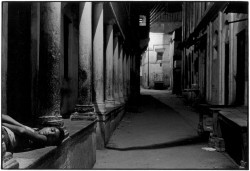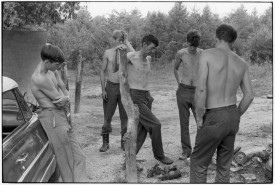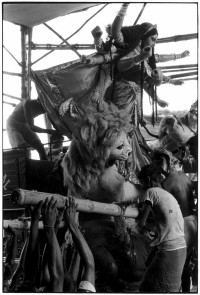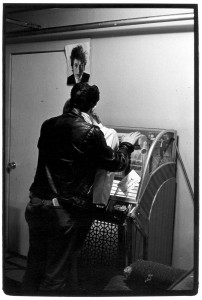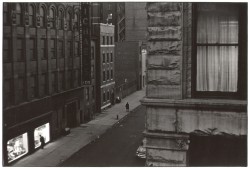Chronology of William Gedney’s Life and Work
1930s-1950s
1932
October 29, 1932 William Gale Gedney is born to William and Violet Gedney in Albany, NY. He has one sibling, a younger brother, Richard Gedney. In 1948, the family moves to Greenville, NY.
1951
Finishes high school and, with a state scholarship, moves to Brooklyn to attend Pratt Institute. (Illustration, right: William Gedney as a Student at the Pratt Institute, ca. 1955)
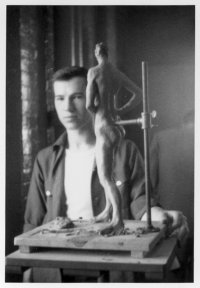
1955
Graduates with a BFA in Graphic Design from the Pratt Institute and begins work at Condé Nast. Discovers his affinity for the camera when he takes a course at Pratt with Walter Chivardi.
1957
Resigns from the art staff of Glamour magazine, explaining in a memo to his superior that he intends to devote himself to his “personal” work.
1957-1959
Gedney makes a meager living doing free-lance and part-time work. He begins to photograph in Brooklyn and works on a series of photographs of the Brooklyn Bridge. He also photographs his grandparents at their home in Norton Hill, NY, for a series he titles The Farm.
1960s
1959-1962
Low on funds, Gedney returns to full-time employment at Watson Products Co. where he works in advertising.
1962-1964
Gedney leaves Watson Products Co. for a job at Time, Inc. as a graphic designer specializing in the layout of photographs for publication.
1964
Having saved enough money, Gedney resigns from Time, Inc. to devote his time exclusively to his own photography.
July 1964
Travels to Eastern Kentucky to photograph. William Gedney stays with and photographs the Boyd Couch family for a few weeks. Then Gedney meets the Cornett family — Willie, recently laid off from the coal mines, his wife Vivian, and their twelve children — and he moves in with them for 11 days. (Illustration, right: Kentucky, 1964)
1965
Begins a series of portraits of contemporary American composers, a project that grows out of his love of music. Gedney writes each of the composers that he wants to photograph and arranges a visit to their home or studio. He pursues this project over several years, eventually creating a book dummy of the work with portraits of fifty composers.
1966-1967
Receives a John Simon Guggenheim Memorial Fellowship to pursue “Photographic Studies of American life”. In the application, Gedney includes photographs from “The Farm,” Eastern Kentucky, and the series on American composers, and has recommendations from Walker Evans, who he knew slightly from Time, Inc., and from John Szarkowski, who had seen and liked the Kentucky work.
October 1966 – February 1967
Photographs the hippie youth culture of San Francisco. During this time Gedney also meets and befriends the writer Eric Hoffer and his companion, Lili Osborne.
1968
William Gedney’s series of portraits of American composers is accepted and scheduled for publication in 1969 by Crowell, Collier, and Macmillan, Inc. The book’s writer, however, fails to deliver a text. Final notification that the book would not be published does not come until 1975. (Illustration, right: Aaron Copland, 1966) Composers Book Dummy, ca. 1967
December 17, 1968 – March 10, 1969
Gedney exhibits his work at the Musuem of Modern Art in New York in a one-man show, curated by John Szarkowski. William Gedney: Photographs of Eastern Kentucky and San Francisco includes 44 photographs, 42 of which are available online.
1969
Gedney is hired to teach photography at his alma mater, the Pratt Institute, and at Cooper Union. Diane Arbus recommends that he take over her classes at Cooper Union.
1969
Begins a series of photographs from his apartment window overlooking Myrtle Avenue in Brooklyn. To compliment these photographs, Gedney creates two notebooks devoted to the history and culture of Myrtle Avenue: Myrtle Avenue Book I, 1969 and Myrtle Avenue Book II, 1969-1979. (Illustration, right: Myrtle Avenue, Brooklyn, 1969)
Summer 1969
Gedney is one of six photographers chosen to document the work of the Social Security Administration in Hays, Kansas.
1970s
1969 – 1971
Receives a Fulbright Fellowship to go to India. He arrives in Delhi in November 1969 and soon travels to Benares, where he lives and photographs in the old part of the city for fourteen months. (Illustration, right: Benares, 1969-1971)
1971
Gedney returns to New York via Japan where he meets Yamagishi. A twelve picture portfolio of his photographs is published in Camera Mainichi, March 1971.
1972 – 1973
Receives a C.A.P.S. (New York State Creative Artists Public Service) Program Fellowship Grant for Photography.
August 1972
Gedney returns to Eastern Kentucky to photograph. He stays with the Willie Cornett family for 18 days. (Illustration, right: Kentucky, 1972)
July 1973
A sixteen page portfolio of Gedney’s photographs is published in Seiko, Tokyo.
1974
Gedney travels to Europe, and photographs in Ireland and in England.
December 1974
Gedney moves to 603 Third Street in Brooklyn to live in the basement apartment of a brownstone owned by his close friends, Arnold and Anita Lobel.
1975 – 1976
Receives a National Endowment for the Arts Grant in Photography. Gedney travels and photographs in the U.S., spending most of his time on the West Coast in San Francisco and Los Angeles.
1978 – 1980
Gedney’s work is represented in the exhibition and book, Mirrors and Windows: American Photography Since 1960, by John Szarkowski.
1980s
1979 – 1980
Gedney saves enough money to return to India. He lives and photographs in Calcutta for four months. (Illustration, right: Calcutta, 1980)
Summer 1982
Gedney travels to Paris, staying with his friends, photographer Raghubir Singh and his wife, Anne.
November 1984
Arnold and Anita Lobel divorce and their Brooklyn brownstone is sold. William Gedney temporarily moves into Pratt Institute faculty housing.
November 1985
Gedney buys and moves into a fixer-upper house on Staten Island.
Fall 1985
The Museum of Modern Art purchases three India photographs, and Gedney donates four more prints selected by John Szarkowski for the MoMA permanent collection.
1986
Gedney begins renovation of the Staten Island house, but suffers from fatigue and ongoing health problems.
May 1987

Gedney notices a lesion on his arm and visits a doctor. He is diagnosed with AIDS and Kaposi Sarcoma. (Illustration, right: William Gedney, Staten Island, 1987 by Lee Friedlander)
Winter 1987
Aperture Issue #105 includes seven photographs from Gedney’s night series in Benares, India.
1987
Gedney comes up for tenure at the Pratt Institute, and though he has the support of faculty, is denied a permanent position. In an unusual move, he is allowed to continue teaching at Pratt as an adjunct professor, teaching the same course load, but for lower pay and with reduced benefits.
June 23, 1989
William Gedney dies at home on Staten Island. He leaves responsibility for his photographic archive to close friend Lee Friedlander and to John Szarkowski. Because of his curatorial position at MoMA, Szarkowski declines. All other personal property is left to his brother, Richard Gedney. Maria Friedlander acts as executor of William Gedney’s estate.
1990s
1990
According to Gedney’s spoken wish, Lee and Maria Friedlander arrange for his eight cameras and over eight hundred photography books to be donated to the Chitrabani Art College in Calcutta, India, creating the William Gedney Photography Library.
August 1989 – 1992
William Gedney’s photographic archive is housed at the Museum of Modern Art in New York while a permanent home is sought.
May 1992
The photographic archive, consisting of finished exhibition prints, work prints, negatives, contact sheets, book dummies, and some notebooks is officially donated by Lee Friedlander and Richard Gedney to the Rare Book, Manuscript, and Special Collections Library of Duke University in Durham, North Carolina.
1992
Seven of William Gedney’s photographs are included in The Young Rebel in Photography, 1950-1970 at the Musuem of Modern Art in New York, organized by Edward Robinson. (Illustration, right: Chicago, 1966)
1992 – 1994
The William Gedney Photographs and Writings Collection is catalogued by Donna Longo DiMichele and her assistant, Phoebe A. Evans. The 117 boxes include 49,870 items and occupy 51.3 linear feet of shelf space.
1993
Margaret Sartor begins working in the William Gedney archive toward the creation of a book and an exhibition.
Fall 1995
DoubleTake Magazine at the Center for Documentary Studies at Duke University publishes a portfolio of ten of Gedney’s photographs from Eastern Kentucky selected by Margaret Sartor and Alex Harris.
1996
Through a series of interviews with people who knew or worked with William Gedney, Margaret Sartor learns of the existence of other notebooks, writings, and saved correspondence which were not part of the original donation to Duke University, and remain in the possession of Richard Gedney.
1997
At the request of the library, Richard Gedney donates several more boxes of material to the Rare Book, Manuscript, and Special Collections Library at Duke University. These boxes include William Gedney’s personal and non-photographic items: notebooks, diaries, correspondence, appointment books, drawings, and sketch books. (Illustration, right: Pages from Transcriptions and Notes I, 1971-1981)
1997
Under the auspices of the Center for Documentary Studies, Geoff Dyer comes to Duke University and stays for two months, working in the Gedney archive, writing an essay on William Gedney, and working with Margaret Sartor to edit Gedney’s notebooks and writings for her proposed book.
1998
Aperture Magazine publishes a series of seven photographs from Gedney’s India work in, India: A Celebration of Independence.
December 1999
What Was True: The Photographs and Notebooks of William Gedney, edited by Margaret Sartor and co-edited by Geoff Dyer is published as a Lyndhurst Book by the Center for Documentary Studies at Duke University in association with W. W. Norton & Company. (Illustration, right: Brooklyn, 1969)
December 1999
Five thousand items from the William Gedney Photographs and Writings Collection at Duke University are placed online in the Photographs and Writings of William Gedney web site.
2000
January 21, 2000
Short Distances and Definite Places: The Photographs of William Gedney, a retrospective one-man show of William Gedney’s photographs opens at the San Francisco Museum of Modern Art. The show travels to several U.S. venues. 89 of the photographs featured in the exhibition are available online.
See Exhibitions and Publications for a complete chronology of Gedney’s exhibitions, published work, and grants and fellowships.



